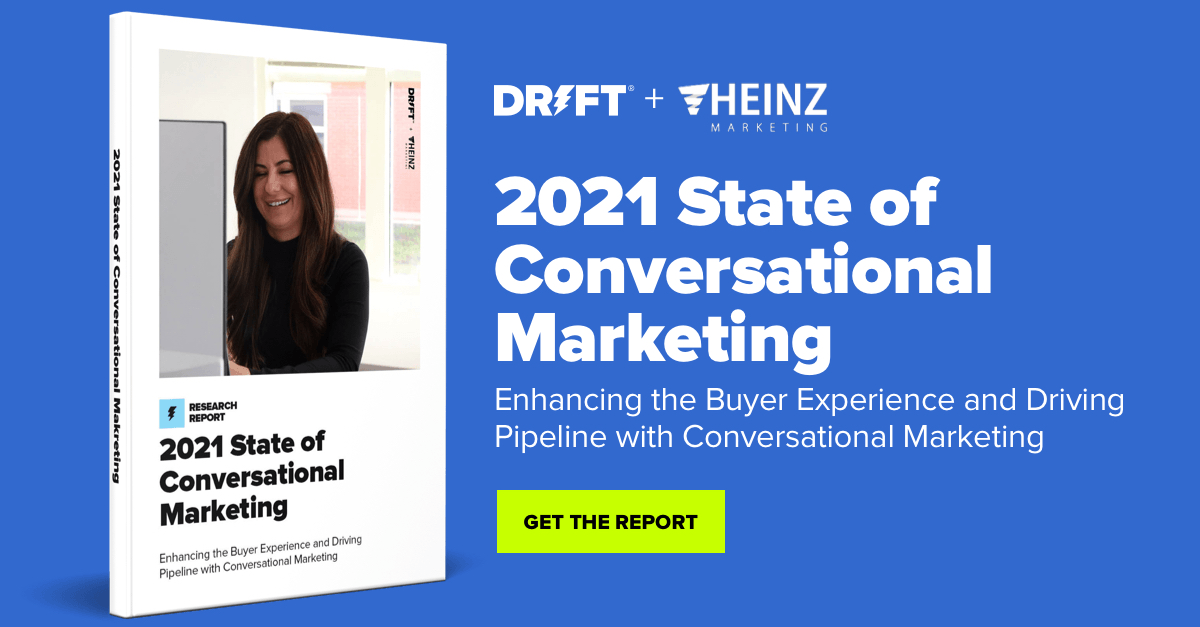We’ve all had bad buying experiences before.
The “bang your head against a wall, convoluted circus show” kind of bad experiences.
The “20 minute wait time, get hung up on” bad experiences.
The “question your sanity” kind of bad experiences…
You get the gist — we’re all a bit jaded. B2B or B2C, everyone has a war story or two they can share.
Unfortunately, according to our most recent research, these jaded moments are increasing among B2B buyers.
Let’s dive into why that is and what marketers can do now to make it right 👇
Why Are Buyers More Frustrated with B2B Marketing Experiences?
With the pandemic forever changing how people buy and sell, many organizations needed to pivot their digital buying experiences. Unsurprisingly, our research shows that patience is wearing thin when it comes to buyer interactions with B2B sellers.
Between 2020 and 2021, here’s what changed:
- Frustration with accessing basic business information has grown 20%
- Frustration with website navigation has grown 25%
- Frustration with old school forms has grown by 27%
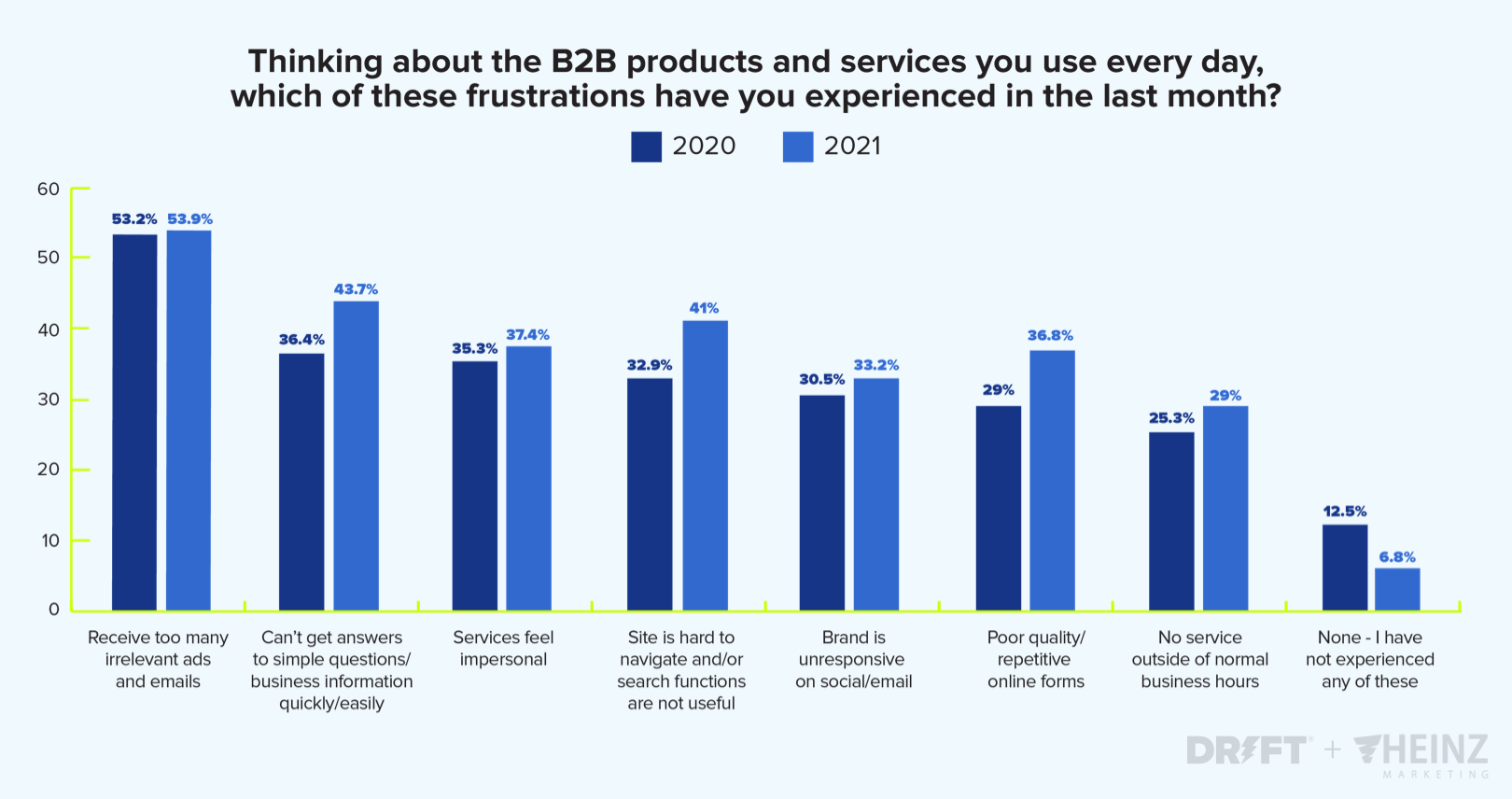
Marketers recognize that there is major room for improvement. But, 78% say that there are significant skill and knowledge gaps on their team.
There’s a lot at risk if marketers don’t put their resources into addressing buyer frustrations. With so many options available, buyers will quickly seek answers elsewhere if you aren’t up to the task of helping them.
How Conversational Marketing Can Reduce Buyer Frustration
But there’s a better way forward. Conversational Marketing replaces traditional contact forms to give buyers access to quick, accurate responses across chat, email, and video. This saves time for buyers while reducing the frustration of going through the traditional sales hoops. Meanwhile, sales reps don’t have to wait days for a qualified buyer to land in their lap.
Of the respondents who have a Conversational Marketing solution, 50.7% say that it helps their business provide quicker responses to inbound queries, and 46.3% say that their solution allows them to learn more about their customers.
While Conversational Marketing is a great asset to combat buyer frustrations, the bottom line is that you need to deliver the experience that your buyers want.
From 2020 to 2021, here’s where we saw the greatest gains with expectations for Conversational Marketing solutions:
- Receiving personalized results increased by 21%: Buyers want responses that are personalized to their needs.
- Getting an instant response increased by 16%: When using a chatbot, 59% of buyers expect to receive a response within five seconds or less.
- Friendliness and approachability of a brand increased by 15%: In 2021, 34% of respondents chose this as a top positive experience factor. That’s even higher than the expectation for an instant response.
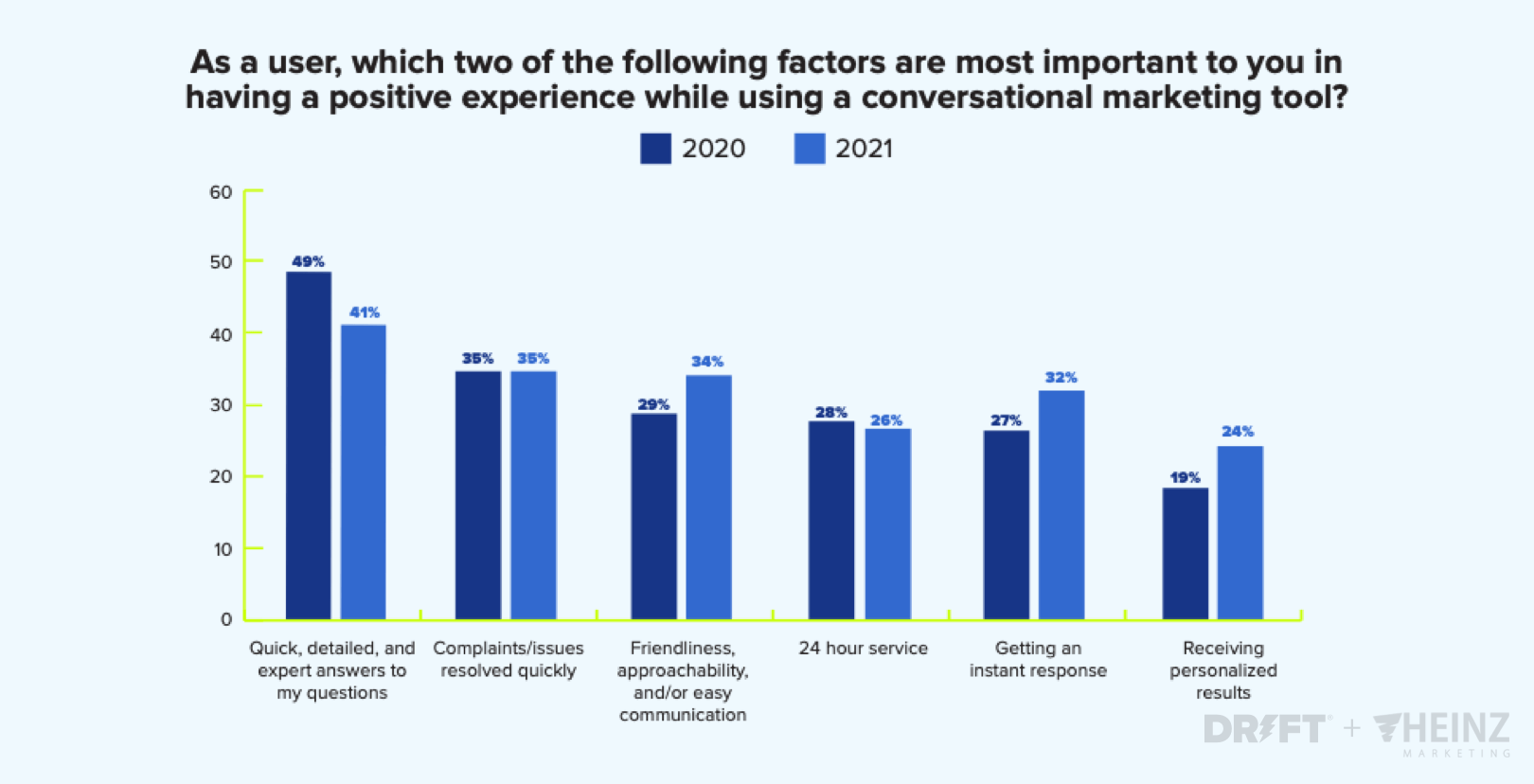
In short, B2B buyers expect a Conversational Marketing solution to be personalized, instantaneous, and human.
6 Ways to Meet Buyer Demands & Provide Great Conversational Marketing Experiences
So, how do you meet and exceed these buyer expectations? Here are some key ways you can use Conversational Marketing to improve the experience for your website visitors, buyers, and customers.
1. Create More Meaningful Conversations
What’s getting in the way between you and more qualified buyers? The answer might be your chatbot sequences.
To provide a better conversational experience, craft unique chatbot sequences for different pages and assets on your website. For example, on a product page about your security features, you can use the following hook:
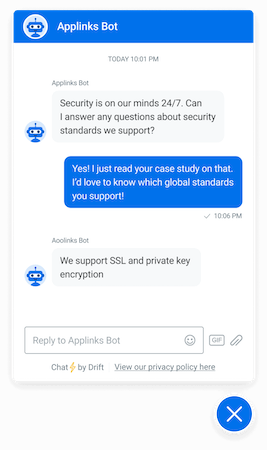
By tailoring your message to be relevant to specific pages, you increase your chances of starting a conversation that converts a site visitor.
In addition, make sure to craft responses to common questions and provide links to helpful resources through your chatbots. For example, you could include a link to an integration page, product page, or free guide in your responses.
This is a great place to leverage AI. Unlike rule-based chatbots, AI chatbots are trained to analyze and respond to open text. Buyers thus have the power to lead the conversation — asking specific questions and addressing their needs just as they would with a human sales rep.
2. Use Personalization As Much As Possible
If you want to successfully start a conversation, you’re going to need a good hook. The best way to do this is to personalize as much as possible, regardless of the channel you’re using.
For chatbots, you want to immediately draw the site visitor’s attention. Personalize your chat prompts by addressing the site visitor by name, referencing the industry they work in, or making note of their recent activity on your website. Here’s an example of a chat prompt for a target account:
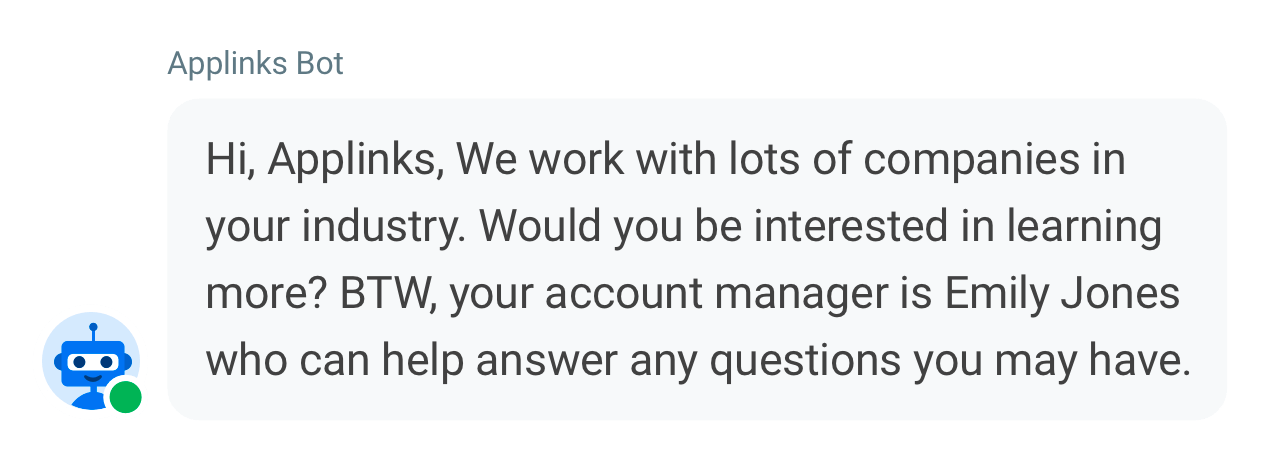
When it comes to email, personalization is a must: personalized content drives up the average reply rate from 11% to 24%. So, instead of sending a generic message to all target accounts, segment your email list based on things like industry, sales stage, or buying behavior. This way, you ensure your messages are relevant and will add value for the buyer.
Finally, a human touch goes a long way. Send personalized videos to high-intent buyers to deliver a thoughtful message directly. Through video, buyers get the chance to put a face to the name and connect with you more easily.
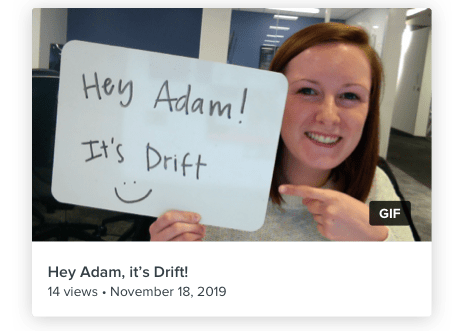
3. Connect Qualified Buyers with Sales Instantly
When a buyer raises their hand to speak with sales, they shouldn’t have to jump through hoops to make it happen. Using Conversational Marketing, you can instantly connect buyers and sellers across chat, email — and now — forms.
Not all companies can totally do away with forms. If that’s the case for you, try automating your forms using Drift Fastlane. Fastlane immediately identifies qualified buyers from completed forms and lets them “skip the line” to chat with sales or book a meeting with an assigned rep. And that all happens on the same page.
B2B is no longer in the era of static forms. 32% of buyers expect forms to be completely automated. That’s a 128% year-over-year growth from last year’s results. As digital acceleration continues, companies need to focus on creating a dynamic conversational experience — whether that starts with one automated form or an overhaul of all forms on your website.
4. Roll Out the Red Carpet for Target Accounts
When it comes to your most qualified buyers, you don’t want to make them wait. With conversation routing, you can automatically connect buyers to their main point of contact when it’s time for a human to take over. You can even set a fallback, or second person, to respond to the buyer when needed.
Drift Prospector also notifies your team whenever an account takes action on your site. This allows them to immediately send a custom chat prompt to that visitor to start a fresh conversation. And, even if the account owner is not available, another rep can easily hop in if the buyer has a question.

5. Give All Site Visitors the Resources They Need
Obviously, you want to route qualified buyers to sales as soon as possible. But what do you do with unqualified buyers?
You don’t want to completely ignore a visitor just because they’re not qualified. Instead, use chatbot sequences to point them towards useful resources, such as ebooks and webinars. This way, you can address their needs and interests while potentially setting them up to be a customer one day. You can even create specific nurture content for this purpose.
6. Get Certified in Conversational Marketing
To really meet buyer expectations for Conversational Marketing experiences, you need to dive deeper. Upskill your team with training that guides them through best practices, as well as more complex strategies and feature implementations.
Drift offers a Conversational Marketing Certification you can take today which will teach you how to create the best experience for site visitors that will convert them into leads.
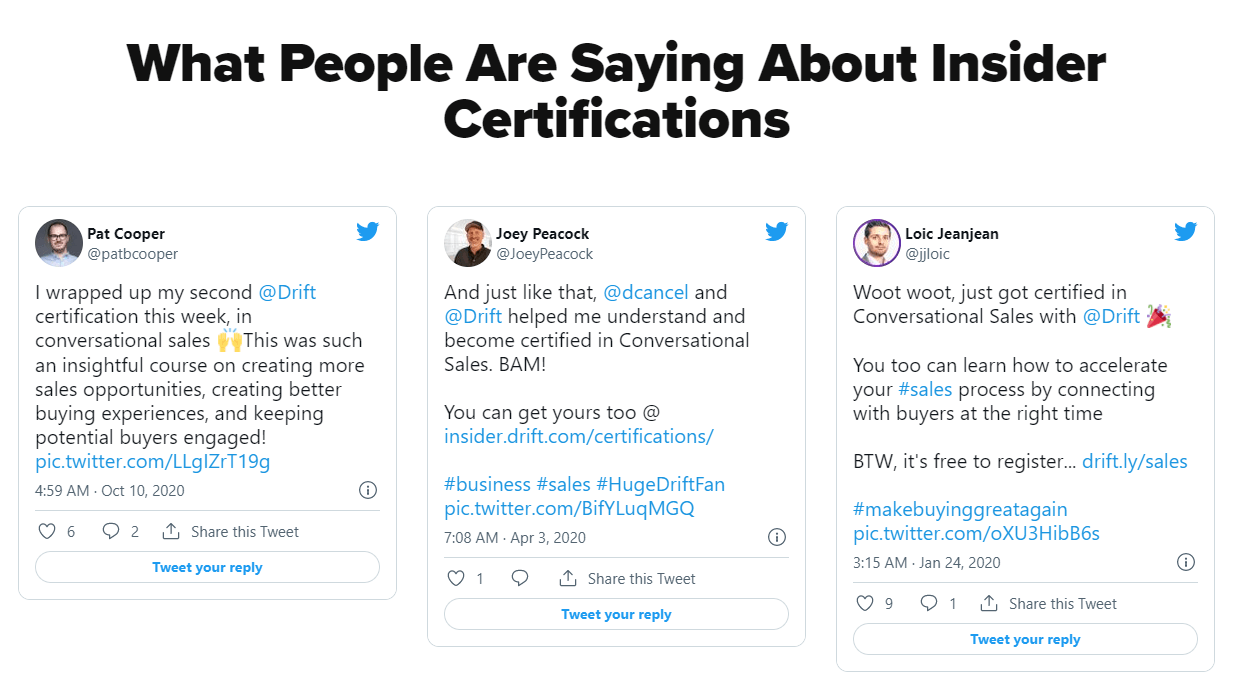
Click here to check out our other certifications. You can also make a free Drift Insider account to access more training videos to up your Conversational Marketing game.
Final Thought
What’s our biggest takeaway from 2021? Conversational Marketing experiences will only get more automated, personalized, and human from here.
It’s not just time for B2B sellers to use Conversational Marketing. It’s time they used it well.





